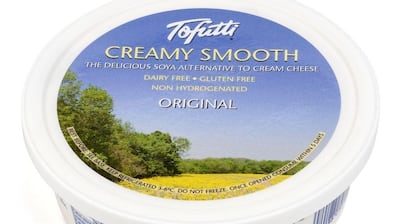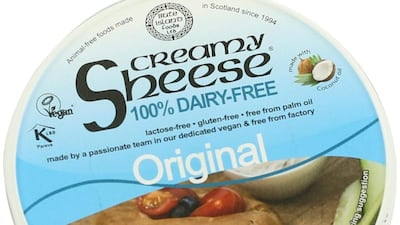The appetite for fake foods that try to evoke old favourites escapes me. Why would anybody want a bleeding veggie burger? Or rubbery slices of cheese alternative?

Why not just eat something else?
But one food many vegans and the lactose-intolerant miss is cheese.
Now it is surprisingly easy to find a variety of cheese substitutes in supermarkets and health food shops. So what can you tell about these products from the labels?
The first thing you notice is that many are made from soya beans or nuts, such as cashews, and oil. Take Tofutti Creamy Smooth, which describes itself as “the delicious soya alternative to cream cheese”. It is made by British company Triano Brands and the “original flavour” product is made from: water, cold-pressed natural oil blend (soya bean, palm fruit and olive), maltodextrin, soy protein, tofu (soya), non-dairy lactic acid, sugar, stabiliser (carob bean, guar, cellulose, xanthan [sic]) and salt. So it’s mostly water and oil. The gloopy cheesy feel comes mostly from the soy protein and tofu, which is soya bean curd.

It is made from soya beans, which are from the same family as peas and have been grown in China for thousands of years. The difference now is that many of those beans in processed foods are genetically-modified ones grown in the United States or Brazil, the world’s biggest exporters. (Soya and tofu are written in bold on the label as soya is one of the common allergens food manufacturers must highlight.)
Non-dairy lactic acid is made by fermenting sugars from carbohydrates such as cornstarch, potatoes or molasses.
This packet also highlights that it is “dairy-free”. That’s to save confusion as some may think lactose-free means dairy-free, but it doesn’t. So for example “lactose-free” cow’s milk simply has the enzyme lactase added to aid digestion. It also has a K symbol in green with the word “Parve” underneath indicating the spread is kosher.

Another option is Creamy Sheese from Scotland. Its “original 100 per cent dairy free spread” is made in a dedicated “vegan and free-from factory” at Bute Island Foods. It has water, coconut oil (24 per cent), soya protein concentrate, salt, acidity regulator: lactic acid (dairy-free), sugar, thickener (carrageenan) and natural flavourings. So it too relies on soya. There is a small V for vegan symbol on the front and a note saying it makes “animal-free food”, which is good to know as natural flavourings can be from animal sources as well as plants.
The “Cheddar style spread” has spirit vinegar, yeast extract and paprika extract for colour in addition to the other ingredients. Yeast extract is popular as it can give a rich, savoury taste, though it does have a high concentration of glutamate. This tastes like very cheap processed cheese, but it can be used to make a grilled sandwich. Sheese also offers herb, garlic and chili flavours.
A more expensive product is Happy Cashew, which describes itself as a “raw, vegan, fermented cashew product”. It is “100 per cent organic,” which means no genetically-modified ingredients. Its organic credentials are highlighted with a hexagon symbol on the front with the word “Bio” inside indicating the German government’s approval. It contains cashews (88 per cent), water, salt and vegan fermentation cultures, which can be made using vegetables. It costs almost €12 for 150g, but then it may be worth it given the lack of stabilisers, preservatives and additives.

Violife works well for those who can’t or do not want to eat soya or cashews. It is made using water, coconut oil (24 per cent), starch, sunflower kernel grounded, sea salt, cellulose as a thickener, non-dairy lactic acid as an acidity regulator, flavourings, olive extract, colour from B-carotene and vitamin B12.
Beans and nuts are good for protein but don’t have the levels of calcium or vitamins, such as vitamin B12 and vitamin D, seen in real cheese. That’s why these are often added to dairy-free alternatives.
Violife’s cheddar version also has cheddar flavour, whose origins it does not explain, and modified starch, which maker Arivia notes is “not to be confused with GMO (genetically-modified) ingredients”. Modified starch can be used as a bulking agent, stabiliser and a thickener. It pops up a lot in the ingredient lists of cheap products, such as baked beans and ready meals.
Many of these cheese alternatives have similar additives and processing agents seen in other processed foods, thus tarnishing their healthy halo.
Vegan cheese alternatives lack the subtlety of flavour of the real thing.
For those who need or want them, however, there are more and better choices appearing on Irish shelves all the time.
FOOD LABELS SERIES
- Bread
- Soup
- Crisps
- Sliced ham
- Cream crackers
(search other food labels articles here)










